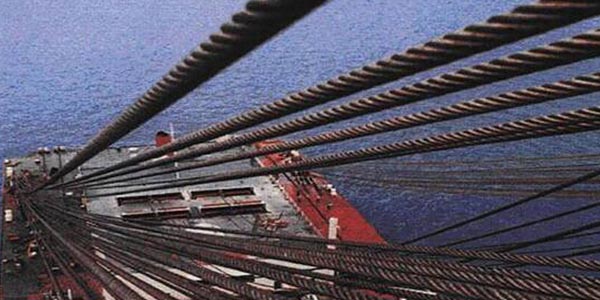1. What is wire rope?
By definition, wire rope is a twisted bundle of drawn steel wires. It is usually composed of wires, strands and a core. The wires are drawn to a pre-determined size and laid together in various arrangements having a definite pitch (or lay) to form a strand. The required number of strands are helically laid or formed around the core, which may be a core of synthetic or natural fiber, a metallic strand or an independent wire rope core.
The size, number and arrangement of wires, the number of strands, the lay and the type of core in a rope are determined largely by the service for which the rope is to be used. Flexibility and abrasion are the most important considerations; other factors, such as load conditions, rope speeds, vibration, crushing, and equipment design also must be considered.
In general, the greater the number of wires in a strand and the greater the number of strands, the more flexible the rope. Flexibility should not be confused with bending fatigue resistance, (i.e., a fiber core rope is more flexible but frequently gives poorer service than an IWRC rope, particularly if sheaves are small and loads are heavy). Hoisting ropes require flexibility and are usually made up of six or eight strands with 16-26 wires per strand for the 6 by 19 classification and 27-49 wires per strand for the 6 by 37 classification.
Flexibility is not a requirement for guy wires, highway guards and similar services; therefore, six strands of seven larger diameter wires (called six by seven) construction are suitable. The selection of wire rope for a particular service should be made in accordance with types recommended by engineers of wire rope manufacturers. Some service conditions require rope with special qualities.
Wire strand cores may or may not be the same construction as the outer strands of the rope. Steel cores of either strand or IWRC give the most solid support and must be used when loads are heavy, there are shock loads and the temperatures are above 212°F.
Wire ropes may be zinc-coated or made from stainless steel wires to resist certain types of corrosion.
Practically all wire rope manufactured today is the preformed construction. This means the wires and strands have been preset during manufacturing into the permanent helical shape they take in the completed rope. Preforming improves the operating characteristics of rope and decreases the possibility of damage during handling. Because the wires of preformed rope tend to remain in position when broken, closer inspection is necessary to detect broken wires.
2. Deterioration of wire rope
Deterioration of wire rope is largely due to factors that may vary considerably in importance, depending on the conditions of service. For example, corrosion is often the principal cause of deterioration of mine hoisting rope in wet mine shafts because of moisture and the presence of acid in the water.
Other factors contributing to deterioration are:
Wear—particularly on the crown or outside wires, from contact with sheaves and drums.
Corrosion—particularly of the interior wires, indicated by pitting and often caused by drying due to lack of lubrication and exposure to heat or moisture. This condition is difficult to detect and is highly dangerous. Corrosion also interferes with the movement of the wires and hastens fatigue failure.
Kinks—acquired during improper installation of new rope or caused by sudden release of the load and by knots made to shorten the rope, hoisting with slack in the rope, etc. A kink is a defect that cannot be removed or corrected.
Fatigue—the breakage of wires from flexure while operating under normal conditions. Repeated bending over sheaves under normal loads or even axial flexure.
Pendants eventually cause wires to break. The wire break is usually square across the wire, but frequently is the “Z” type. Heavy loads, corrosion and lack of lubrication accelerate fatigue failure. Operation on undersized sheaves and drums also hastens failure from fatigue.
Drying out of lubrication—often hastened by heat.
Overloading and over winding—not following safe working load charts.
Mechanical abuse—such as crushing and cutting wires or dragging ropes.
(Note: the above quoted from 《National Safety Council Data Sheet 667 Reaf. 89 Rev. June 2005》)
3. TST Flaw Detection Technology Co., Ltd. (TST)
TST is a company that provides equipment and solution for advanced onsite NDT inspection and lubrication of steel wire ropes.
3.1 TST Flaw Detection System (TST FDSysTM)
TST-FDSysTM is created by TST scientists and engineers to automatically inspect the physical flaws on the wire ropes. Given the inspected flaw data, the system can thus make evaluations of the wire rope safety status and operating performance of the targets. For the onsite engineers and operating managers, TST-FDSysTM will provide both realtime wire rope inspection monitor alongside the producing operation and comprehensive report at end of per inspection task. Therefore, flaws on the inspecting target will be noticed instantly wherever it appears and the automatically generated report will demonstrate the overall status of the target with detailed analysis of each inspected flaw.
The value of TST technology and solution is generated from two aspects:
Enhance safety and maintenance decision process by providing detailed and accurate inspection data.
Reduce costs of wire rope usage and maintenance planning/downtime by introducing efficient inspection procedure and reliable evaluation of wire rope working life.
3.2. TST-Viper Wire Rope Lubricator
TST-Viper Wire Rope Lubricator is an Australian designed and built lubricator for wire rope sizes from 8mm to 165mm. It provides fast and effective single pass lubrication of wire ropes, eliminating the slow and arduous task of manual wire rope lubrication. TST-Viper Wire Rope Lubricator provides superior protection against corrosion and fretting wear by forcing lubricant into the core of the wire rope while also coating the outer strands. The use of TST-Viper Wire Rope Lubricator improves operator safety and reduces the environmental impact of wire rope lubrication for any size operation.
More Than Safer






